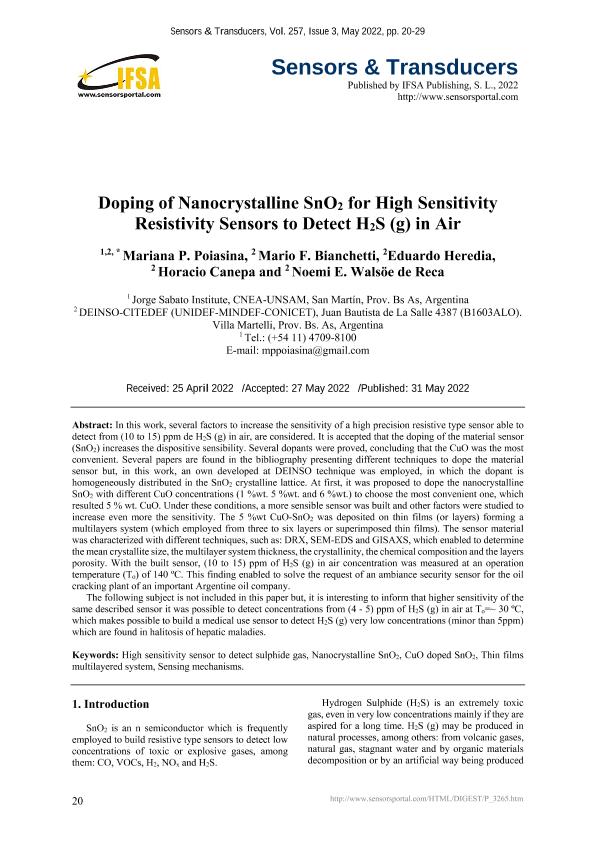Artículo
Doping of nanocrystalline SnO2 for high sensitivity resistivity sensors to detect H2S (g) in air
Poiasina, Mariana Paola ; Bianchetti, Mario Fidel
; Bianchetti, Mario Fidel ; Heredia, Eduardo Armando; Canepa, Horacio Ricardo
; Heredia, Eduardo Armando; Canepa, Horacio Ricardo ; Walsöe de Reca, Noemi E.
; Walsöe de Reca, Noemi E.
 ; Bianchetti, Mario Fidel
; Bianchetti, Mario Fidel ; Heredia, Eduardo Armando; Canepa, Horacio Ricardo
; Heredia, Eduardo Armando; Canepa, Horacio Ricardo ; Walsöe de Reca, Noemi E.
; Walsöe de Reca, Noemi E.
Fecha de publicación:
05/2022
Editorial:
International Frequency Sensor Association
Revista:
Sensors & Transducers
ISSN:
2306-8515
e-ISSN:
1726-5479
Idioma:
Inglés
Tipo de recurso:
Artículo publicado
Clasificación temática:
Resumen
In this work, several factors to increase the sensitivity of a high precision resistive type sensor able todetect from (10 to 15) ppm de H2S (g) in air, are considered. It is accepted that the doping of the material sensor (SnO2) increases the dispositive sensibility. Several dopants were proved, concluding that the CuO was the most convenient. Several papers are found in the bibliography presenting different techniques to dope the material sensor but, in this work, an own developed at DEINSO technique was employed, in which the dopant is homogeneously distributed in the SnO2 crystalline lattice. At first, it was proposed to dope the nanocrystalline SnO2 with different CuO concentrations (1 %wt. 5 %wt. and 6 %wt.) to choose the most convenient one, which resulted 5 % wt. CuO. Under these conditions, a more sensible sensor was built and other factors were studied to increase even more the sensitivity. The 5 %wt CuO-SnO2 was deposited on thin films (or layers) forming a multilayers system (which employed from three to six layers or superimposed thin films). The sensor material was characterized with different techniques, such as: DRX, SEM-EDS and GISAXS, which enabled to determinethe mean crystallite size, the multilayer system thickness, the crystallinity, the chemical composition and the layers porosity. With the built sensor, (10 to 15) ppm of H2S (g) in air concentration was measured at an operation temperature (To) of 140 ºC. This finding enabled to solve the request of an ambiance security sensor for the oil cracking plant of an important Argentine oil company.The following subject is not included in this paper but, it is interesting to inform that higher sensitivity of the same described sensor it was possible to detect concentrations from (4 - 5) ppm of H2S (g) in air at To=~ 30 ºC, which makes possible to build a medical use sensor to detect H2S (g) very low concentrations (minor than 5ppm) which are found in halitosis of hepatic maladies.
Archivos asociados
Licencia
Identificadores
Colecciones
Articulos(UNIDEF)
Articulos de UNIDAD DE INVESTIGACION Y DESARROLLO ESTRATEGICOS PARA LA DEFENSA
Articulos de UNIDAD DE INVESTIGACION Y DESARROLLO ESTRATEGICOS PARA LA DEFENSA
Citación
Poiasina, Mariana Paola; Bianchetti, Mario Fidel; Heredia, Eduardo Armando; Canepa, Horacio Ricardo; Walsöe de Reca, Noemi E.; Doping of nanocrystalline SnO2 for high sensitivity resistivity sensors to detect H2S (g) in air; International Frequency Sensor Association; Sensors & Transducers; 257; 3; 5-2022; 20-29
Compartir



